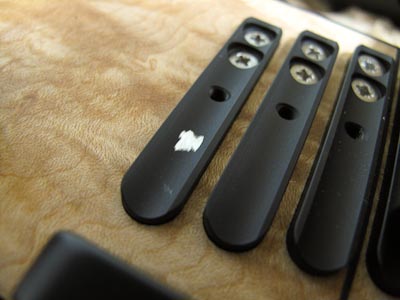Anodized aluminium is not very conductive to electricity, which can lead to string grounding issues. It is quite easy to overcome though, and with recent and future orders, I am including the necessary materials. However, I do not want to make any assumptions on how you would prefer it to work, so I am not grinding off the anodization as described below.
Step 1 – route the ground cable

Drill a hole into the control cavity as usual and run a bare wire through it to the bridge.
Step 2 – grind off anodization

Next, grind off the anodization (using a Dremel for instance) from underneath the base plate.

As well as on top of the base plate. Take care to check an approximate intonation first though. You want to make sure that the area you grind off will be completely covered by the bridge when it is mounted. The ground off portion should sit straight under the saddle.
Step 3 – re-mount with the spring

Lastly, insert the supplied spring into the bridge and re-mount it. The saddle will have full contact with the ground off anodization through the spring, and on to the ground wire that sits under the bridge plate.




Hi Ola,
do the recent bridges have been sanded in some part to accommodate grounding?
I don’t have a dremel around so I thought I ask what other possibilities I can do if I were to buy you bridge.
Thanks
Actually no – but what _has_ happened since this post is that the design now has a different geometry of the mounting holes, and the second screw sits where the saddle usually ends up. So if you wrap your ground cable around the mounting screw, it works without grinding.
Hi Ola,
Do you have to route a ground cable for each individual saddle ? ( I mean 6 ground cables for a 6 string guitar ? )
I have a zero fret that acts as the ground for the remaining strings, but if you don’t then yes, unless you find another way.